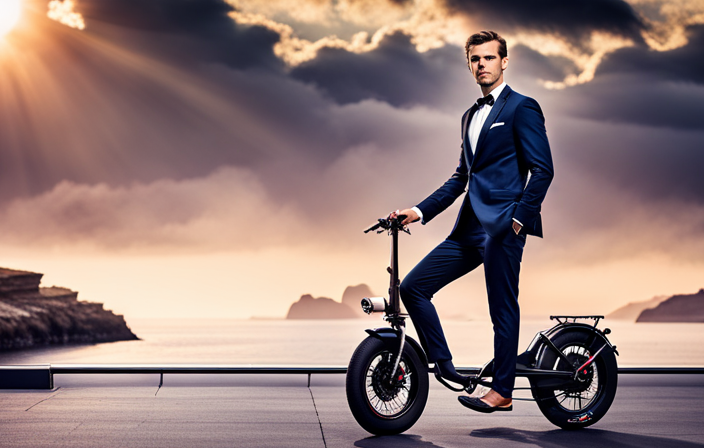Coincidentally, as I embarked on a journey to find the perfect electric bike, I realized the overwhelming number of options available. With so many models, features, and price ranges, the task of picking the right one seemed daunting.
However, fear not, for I have delved deep into the world of electric bikes and have compiled a comprehensive guide to help you make an informed decision. From determining your riding needs to evaluating battery performance, this article will equip you with the knowledge needed to pick the electric bike that suits you best.
Key Takeaways
- Choose a lightweight electric bike with comfortable dimensions for easy maneuverability and transportation.
- Evaluate different electric bike models through test riding, comparing motor power, battery range, and price.
- Research warranty and after-sales support through customer reviews and seeking advice from enthusiasts or professionals.
- Gather information and recommendations from experienced riders, online research, forums, and communities.
Determine Your Riding Needs and Style
You’ll want to figure out your riding needs and style to ensure you find the perfect electric bike that complements your unique personality and fulfills your specific requirements. Consider the type of terrain you’ll be riding on.
If you plan to tackle hilly or uneven trails, a bike with a more powerful motor and sturdy frame might be necessary. On the other hand, if you’ll be primarily riding on paved roads or flat surfaces, a bike with a lighter frame and smaller motor may be sufficient.
Additionally, think about your preferred riding position. Some bikes offer a more upright position, which is great for comfort and visibility, while others have a more aggressive, forward-leaning position for increased speed and efficiency.
As you consider your budget, keep in mind that investing in a high-quality electric bike will provide long-term benefits, such as durability and performance.
Consider Your Budget
When it comes to choosing the perfect e-bike, it’s important to think about your budget and how much you’re willing to spend. Here are some key factors to consider:
-
Riding preferences: Determine the type of terrain you’ll be riding on and the average distance you’ll be covering. This will help you choose the right motor power and battery capacity for your needs.
-
Brand reputation: Research different e-bike brands and read reviews from other riders. Look for brands that have a good reputation for producing high-quality and reliable electric bikes.
-
Price range: Set a budget for yourself and stick to it. E-bike prices can vary greatly depending on the brand, features, and quality. Consider if you want to invest in a higher-end model or if a more affordable option will meet your needs.
-
Additional costs: Remember to factor in any additional costs, such as accessories, maintenance, and warranties.
Considering these factors will help you make an informed decision and find an electric bike that fits both your riding preferences and budget.
Now, let’s move on to choosing the right frame type.
Choose the Right Frame Type
To truly enhance your riding experience, consider the frame type that perfectly suits your needs and style. When choosing an electric bike, frame material and frame geometry are two important factors to consider. The frame material determines the bike’s weight, durability, and overall performance. Common frame materials include aluminum, steel, carbon fiber, and titanium. Each material has its own advantages and disadvantages, so it’s essential to choose one that aligns with your preferences and budget.
In addition to the frame material, frame geometry plays a significant role in how comfortable and efficient your ride will be. Frame geometry refers to the angles and dimensions of the bike frame, which affects your riding position, stability, and maneuverability. There are various frame geometries available, such as traditional diamond frames, step-through frames, and compact frames. Consider your body type, intended use, and personal preferences when selecting the frame geometry that suits you best.
When deciding on the motor type, it’s important to take into account factors such as power, efficiency, and noise levels.
Decide on the Motor Type
Selecting the appropriate motor type for your ride can greatly impact the power, efficiency, and noise levels of your electric bike. When deciding on the motor type, consider the following factors:
-
Motor Power: Choose a motor with sufficient power to meet your riding needs. Higher power motors provide more speed and better performance on hills.
-
Motor Placement: Decide whether you want a hub motor or a mid-drive motor. Hub motors are located in the wheel hub, providing a smoother and quieter ride. Mid-drive motors are positioned in the bike’s center, offering better weight distribution and improved handling.
-
Torque Sensor: Look for a motor with a torque sensor, as it measures the force you apply to the pedals and adjusts the motor assistance accordingly. This feature provides a more natural and intuitive riding experience.
-
Motor Efficiency: Consider the motor’s efficiency rating to ensure optimal energy consumption and longer battery life.
By carefully considering these motor-related factors, you can make an informed decision about the motor type that best suits your needs.
Moving on to evaluating battery performance…
Evaluate Battery Performance
Now, it’s crucial to assess the battery’s performance to ensure your electric bike runs smoothly and efficiently.
When evaluating battery life, it’s important to consider the range it can provide on a single charge. Look for a battery with a higher capacity, as this will allow you to ride longer distances without needing to recharge.
Additionally, comparing battery performance involves considering factors such as voltage, amp hours, and watt hours. These measurements affect how much power the battery can deliver and how long it will last. Look for a battery that offers a balance between power and longevity.
Finally, assessing the range and charging time of the battery is essential. You’ll want a battery that offers a decent range and can be charged quickly, so you can spend more time riding and less time waiting.
Transitioning into the next section, assessing the range and charging time will help you determine the practicality of the electric bike for your needs.
Assess the Range and Charging Time
When considering the range and charging time of your electric bike, imagine effortlessly gliding through scenic landscapes while knowing that your battery can power you for miles on end and recharge quickly, allowing you to spend more time exploring and less time waiting.
-
Range vs. Speed:
A larger battery capacity generally means a longer range. Consider your typical riding distance and choose a battery that can comfortably cover that distance.
Higher speeds drain the battery faster. If you plan on riding at higher speeds, opt for a battery with a larger capacity to ensure a longer range. -
Charging Time vs. Convenience:
Charging time varies depending on the battery and charger. Look for e-bikes with fast-charging capabilities to minimize downtime.
Removable batteries can be charged indoors, offering more convenience.
Consider investing in a spare battery for longer rides or if you frequently commute long distances.
Assessing the range and charging time of your electric bike is crucial to ensure you have the power and convenience you need.
In the next section, we will discuss the importance of looking for quality components to maximize your e-bike experience.
Look for Quality Components
Consider investing in an e-bike with top-notch components for an enhanced riding experience. Quality components are crucial when it comes to electric bikes. While it may be tempting to opt for a cheaper option, it’s important to weigh the quality against the price. Cheaper components may result in a less reliable and enjoyable riding experience.
Look for reputable brands that have a proven track record in the industry. Brand reputation is essential as it signifies the quality and reliability of their products. A well-known brand is more likely to use high-quality components, ensuring better performance and durability.
When it comes to e-bikes, quality components are worth the investment. They not only provide a smoother ride but also contribute to the overall longevity and reliability of the bike.
With that in mind, let’s now consider the bike’s weight and size, which play a significant role in your riding experience.
Consider the Bike’s Weight and Size
Imagine yourself gliding effortlessly through the streets on a nimble feather, effortlessly maneuvering through traffic and conquering hills with ease. When considering an electric bike, it’s important to take into account the bike’s weight and size.
Here are three factors to consider:
-
Weight: Opt for a lightweight electric bike as it will allow you to easily navigate through tight spaces and make quick turns. It will also be easier to carry or transport when needed.
-
Size: Consider the dimensions of the bike, ensuring that it fits your body comfortably. A bike that is too big or too small can negatively affect your riding experience and may even cause discomfort or pain.
-
Frame Material: Look for a bike with a sturdy and durable frame material, such as aluminum or carbon fiber. This will ensure that the bike is both strong and lightweight.
Now that you understand the importance of bike weight and size, it’s time to move on to the next step: test ride different models.
Test Ride Different Models
Now that you’ve grasped the significance of assessing bike weight and size, it’s time to embark on an exhilarating journey of test riding various models. When it comes to bike selection, nothing beats the experience of actually riding the bike before making a decision. Test riding allows you to get a feel for the bike’s handling, responsiveness, and overall comfort. To help you in this process, I’ve created a table comparing different electric bike models based on key features such as motor power, battery range, and price. Take a look:
| Model | Motor Power | Battery Range | Price |
|---|---|---|---|
| A | 500W | 50 miles | $1,200 |
| B | 750W | 60 miles | $1,500 |
| C | 1000W | 70 miles | $1,800 |
| D | 1250W | 80 miles | $2,000 |
By test riding different models and comparing their features, you can find the perfect electric bike that suits your needs. Next, we’ll explore the importance of checking for comfort and ergonomics.
Check for Comfort and Ergonomics
Let’s take a moment to ensure that you’re comfortable and enjoying the ride by checking for a bike that fits your body perfectly.
When choosing an electric bike, it’s important to strike a balance between comfort and performance. Consider factors like seat height, handlebar position, and overall frame geometry to find a bike that suits your body type and riding style.
Some bikes even offer customization options, allowing you to adjust the seat, handlebars, and pedals to your exact preferences. This level of customization ensures that you can ride for longer periods without experiencing any discomfort or fatigue.
Once you find a bike that meets your comfort needs, you can shift your focus to researching warranty and after-sales support, ensuring a hassle-free ownership experience.
Research Warranty and After-Sales Support
Ensure that you research the warranty and after-sales support options available to guarantee a stress-free ownership experience. This step is crucial when picking an electric bike because it ensures that you are protected in case of any issues or malfunctions.
Start by researching customer reviews online to get an idea of the after-sales support provided by different manufacturers. Look for feedback on how responsive they are to customer inquiries and how quickly they address any problems. Additionally, seek expert advice from electric bike enthusiasts or professionals who can guide you towards brands with a reputation for excellent after-sales support.
Having a reliable warranty and accessible support can make a significant difference in your overall satisfaction with the electric bike you choose. With this information in hand, you can move on to the next section about reading reviews and seeking recommendations, which will further help you make an informed decision.
Read Reviews and Seek Recommendations
Start by checking out reviews and reaching out to friends or experts in the field to get their recommendations on which model is the best fit for you. Seeking advice from those who have already experienced electric bikes can provide valuable insights and help you make an informed decision. Online research is also a great way to gather information about different electric bike models. Many websites offer detailed reviews from experts and customers, giving you a better understanding of the pros and cons of each option. Additionally, online forums and communities dedicated to electric bikes can provide a platform for asking questions and receiving recommendations from experienced riders. By reading reviews and seeking recommendations, you can narrow down your options and find the electric bike that meets your specific needs. In the next section, we will delve into how to compare prices and features to make the final decision.
Compare Prices and Features
When comparing prices and features, it’s important to consider your budget and the specific features that will enhance your overall riding experience. Start by researching different electric bike brands and comparing their pros and cons. Look for brands that are known for their reliability, performance, and customer support. Some popular brands include Trek, Specialized, and Giant. Additionally, consider the different features that each brand offers, such as battery life, motor power, and suspension. Think about your riding style and needs to determine which features are essential for you.
In terms of finding the best deals on electric bikes, keep an eye out for sales and discounts from reputable retailers. You can also consider buying a used electric bike, but make sure to thoroughly inspect it and test ride it before making a purchase. Online marketplaces and forums can be great resources for finding used electric bikes. Remember to factor in the cost of any necessary upgrades or repairs when comparing prices.
When considering maintenance and repair needs, it’s important to choose a brand that has a reliable service network and readily available replacement parts. Transitioning into the next section, it’s crucial to think about the long-term costs and support for your electric bike.
Consider Maintenance and Repair Needs
Taking care of regular maintenance and promptly addressing any repair needs is essential to keep your electric bike running smoothly and avoid costly issues down the road. To ensure the longevity of your electric bike, here are some maintenance tips to consider:
-
Keep your electric bike clean and dry, especially after riding in wet or muddy conditions. This helps prevent rust and other damage.
-
Regularly check and tighten all bolts and screws to maintain stability and safety.
-
Lubricate the chain regularly to reduce friction and extend its lifespan.
-
Check the tire pressure regularly and inflate them to the recommended level for optimal performance.
When it comes to repair options, it’s important to choose a reliable and reputable service provider or consider learning basic repair skills yourself. Some electric bike manufacturers offer repair and maintenance services, while others have authorized service centers.
By considering these maintenance tips and repair options, you can ensure that your electric bike remains in top condition. Now, let’s move on to how to make an informed decision when purchasing an electric bike.
Make an Informed Decision
To ensure that you make a well-informed decision, it is crucial to consider various factors before purchasing an e-bike. These factors include your specific needs, budget, and desired features.
When it comes to picking an electric bike, it is important to not only focus on the bike itself but also think about the accessories that come with it. Look for accessories that suit your needs, such as a comfortable seat, fenders to protect you from mud and dirt, and a sturdy rack for carrying your belongings.
Additionally, consider the environmental impact of your choice. Opt for a bike that is made from sustainable materials and has a low carbon footprint.
By considering these factors and making an informed decision, you can ensure that you choose an electric bike that meets your needs while minimizing its impact on the environment.
Frequently Asked Questions
What safety features should I look for in an electric bike?
When it comes to safety features, electric bike helmets are a must-have for protecting your noggin. And don’t forget about electric bike lock options, because you wouldn’t want someone swiping your awesome ride! Stay safe and secure!
How often should I service an electric bike?
You should service an electric bike at least once a year or every 500-1000 miles, whichever comes first. Regular maintenance includes checking the battery, brakes, tires, and drivetrain, as well as ensuring all electrical components are functioning properly.
Can I use an electric bike for long-distance commuting?
Yes, an electric bike is a reliable option for long-distance commuting. With their range and battery life, they provide the necessary power to tackle those extra miles. Plus, the benefits of electric bikes, such as assisted pedaling and reduced physical strain, make them ideal for commuting.
Are there any specific regulations or laws I should be aware of when riding an electric bike?
When it comes to electric bike safety, it’s important to be aware of specific regulations and laws. Understanding and following these rules will ensure a safe and enjoyable ride on your electric bike.
How do I properly maintain the battery of an electric bike?
To properly maintain the battery of an electric bike, it is important to follow the recommended battery charging and storage guidelines. This includes charging the battery fully before each ride and storing it in a cool, dry place when not in use.
Conclusion
After carefully considering my riding needs and budget, I finally chose my electric bike. It’s like finding the perfect companion for my daily adventures.
Just like a well-crafted symphony, every component of the bike works in harmony, from the smooth motor to the long-lasting battery. I feel the surge of power as I pedal, effortlessly gliding through the streets.
It’s a testament to the importance of thorough research and decision-making. So, whether you’re a commuter or an outdoor enthusiast, finding the right electric bike can truly be a symphony of joy.
















